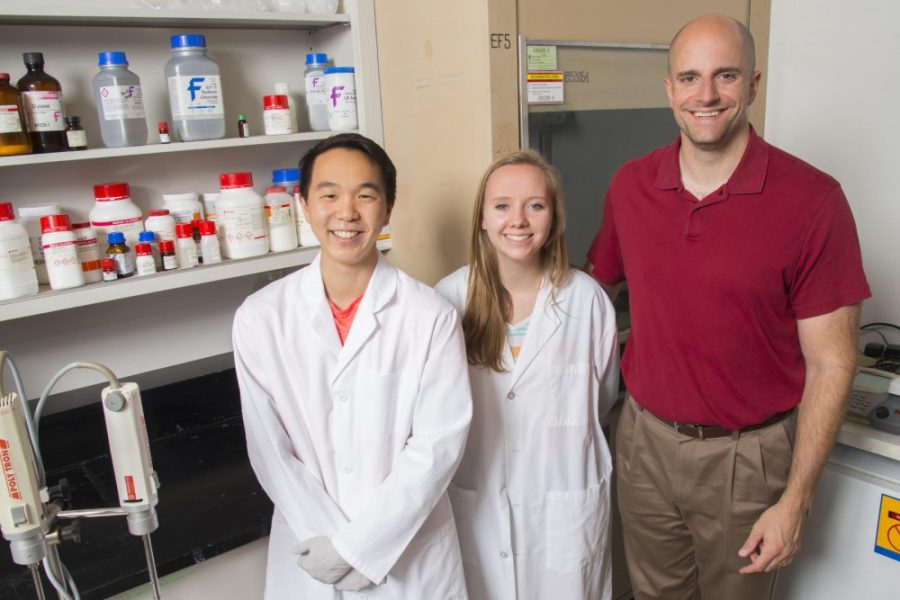John Streicher, assistant professor of pharmacology, opened his laboratory at the University of Arizona three years ago and has focused his research on opioid receptors involved in the regulation of pain, as well as their molecular pathways and signaling, ever since.
Currently, Carrie Stine, an undergraduate in the Streicher lab and a biochemistry and molecular and cellular biology senior, along with other lab members, are examining the role of a specific protein in opioid receptor signaling — Hsp90.
Heat shock protein 90 is in a special category of proteins called chaperones, according to Stine. Chaperones, among other things, help ensure other proteins are built or folded correctly, and therefore can carry out their jobs. Hsp90 is specifically known to help fold oncogenes, those proteins implicated in supporting cancerous tumor growth.
RELATED: Researchers work to improve Parkinson’s disease treatment
While many researchers at the UA are studying opioids and pain, Streicher’s lab takes a unique approach to their research and hopes to develop pain-relieving drugs without the side effects of opioids by examining opioid receptors and the cellular actions they are involved in at the molecular level.
While examining these molecular pathways, Streicher and Stine noticed Hsp90 plays a role in the regulation of pain. Because Hsp90 is a target in popular cancer treatments, the protein’s appearance in their pathways caught the researchers’ attention.
“People inhibit the function of Hsp90 to treat cancer, but this course of treatment could severely block opioid receptors’ ability to modulate pain,” Streicher said.
While this effect is not seen in all forms of cancer, in Streicher’s mouse model it does appear to dramatically reduce opioid efficiency in relieving pain for specific cancer types.
“For some cancers, like bone cancer, Hsp90 inhibition is like a nuclear bomb,” Streicher said.
Streicher and Stine have observed that opioid drugs, such as morphine, are less effective at relieving pain in bone cancer models and can even exacerbate cancer. This can initiate a detrimental cycle of increasing pain and increasing cancer growth.
Streicher and Stine hope their observations can help specialists inform their judgments when deciding the best course of treatment for cancer and its associated pain.
While manipulating Hsp90 may have its drawbacks, it is a tool to fight cancer and, according to Streicher and Stine, could also be used as a tool to fight opioid addiction.
“While Hsp90 has not yet been studied in an addiction model, Hsp90 has been shown to make opioids more effective in the spinal cord without increasing the reward signals that we associate with addiction,” Streicher said.
Further research could help produce better ways to relieve pain that are less addictive and are accompanied by fewer side effects.
According to Streicher, Stine has played a critical role in the lab’s recent detour into the study of pain in cancer.
Stine gave a presentation on her work in the lab at Experimental Biology this year, an annual research conference attended by scientists from around the world. Stine is also writing a research paper based on her data to be submitted to The Journal of Pain for publication next year.
For Stine, the chance to work behind the scenes on a research project has helped her solidify her career goals and future plans.
“I am applying to graduate programs in pharmacology and genetics this fall and hope one day to become a research professor on a university campus,” Stine said.
RELATED: UA Research travels to Capitol Hill
During the last two years, Streicher has watched Stine grow and gain more independence in the lab. For Streicher, part of his job is to help undergraduates in his lab become better scientists.
“I try to help teach undergraduates how to be good scientists and foster their independence in research,” Streicher said.
After graduation, Stine looks forward to continuing her research in a new lab studying fascinating and impactful questions.
Stine and Streicher’s research is supported by UA’s Undergraduate Biology Research Program and an Arizona Biomedical Research Grant as well as by the National Institutes of Health.
Follow Randall Eck on Twitter















